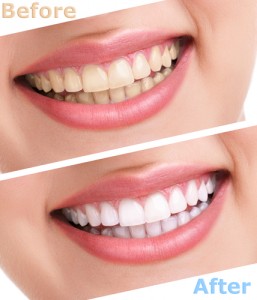Correction for Extrinsic and Intrinsic Stains
 Bright, white teeth play a large role in creating a beautiful smile. When your teeth are dull and discolored, you might find that your smile isn’t as radiant as it should be. Some factors that affect the color of your teeth have to do with diet and health. Luckily, you don’t have to live with stained or discolored teeth. Dr. Fiss offers teeth-bleaching procedures and veneers to whiten your teeth and brighten your smile.
Bright, white teeth play a large role in creating a beautiful smile. When your teeth are dull and discolored, you might find that your smile isn’t as radiant as it should be. Some factors that affect the color of your teeth have to do with diet and health. Luckily, you don’t have to live with stained or discolored teeth. Dr. Fiss offers teeth-bleaching procedures and veneers to whiten your teeth and brighten your smile.
Discolored teeth are more of a cosmetic issue rather than a medical issue. Brownish-yellow or white patches are usually a sign of poor cleaning habits or staining caused by food, drinks, and other activities. However, some stains can be indicative of unhealthy behavior that can lead to serious issues with your teeth.
In general, there are two types of tooth stains: extrinsic and intrinsic.
Extrinsic Stains
Extrinsic stains are the most common type of teeth stains. Extrinsic stains are superficial discolorations, and they are the most common type of teeth stains. Extrinsic stains are generally caused by something you put into your mouth that stains the outer enamel of the teeth.
Common Causes
- Coffee
- Tea
- Dark soda
- Red wine
- Deep-hue berries (blueberries, cranberries, raspberries, blackberries)
- Balsamic vinegar
- Curry
- Tomato sauce
- Tobacco products (smoking or chewing)
Treatment
Extrinsic causes of tooth discoloration can be effectively treated with teeth-whitening treatments to restore bright, white smiles. Tray bleaching is the traditional method for teeth whitening. Over a period of two weeks, you wear form-fitting trays filled with a bleaching liquid for two to six hours per day. For patients looking for an immediate and effective teeth-whitening treatment, Dr. Fiss offers ZOOM! This treatment combines light bleaching with hydrogen peroxide gel to lighten teeth six to ten shade in one hour. This in-office treatment significantly shortens the teeth-whitening process and achieves whiter teeth with just one treatment.
Intrinsic Stains
Intrinsic stains develop deeper inside the teeth and are often indicative of an unhealthy habit. Intrinsic discolorations affect the teeth from the inside out.
Common Causes
- Decay: Tooth decay is the death of the tissue in or surrounding your teeth. Decay presents itself as a greyish-black color and usually begins where the tooth meets the gum. Pulp necrosis will cause the whole tooth to become discolored.
- Medications: Antibiotics that contain tetracycline and doxycycline can discolor still-developing teeth in children, typically those who are under eight years of age. Some antihistamines, antipsychotic drugs, and antihypertensive medications can cause teeth discoloration.
- Aging: As we age, the outer layer of enamel wears away revealing the natural yellow color of the underlying dentin. Grinding and hard brushing can also cause the appearance of the teeth to darken.
- Tooth trauma: Causing nerve damage to a tooth or to the teeth can cause them to darken or become discolored.
Treatment
Surfacing whitening techniques often do very little to correct intrinsic stains. For this reason, intrinsic can be more difficult and time-consuming to treat. Patients with intrinsic discoloration often benefit from permanent solutions for discoloration. Veneers can be used to replace lost enamel or enamel with deeply penetrating stains. In cases of decay, the diseased tooth structure must be cleaned out and the tooth restored with a filling, porcelain veneer, or porcelain crown, depending on the severity of tooth decay. Some patients with advanced tooth decay or severe tooth trauma will need dental implants to achieve the smile correction they desire.
If you’re looking for whiter teeth and a more confident smile through bleaching, schedule a consultation with Dr. Fiss today. Contact our office at (312) 642-6631, or fill out our online contact form for more information.